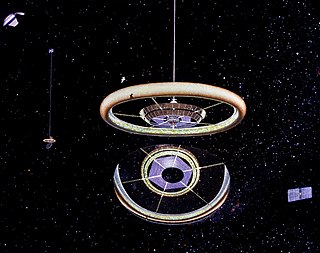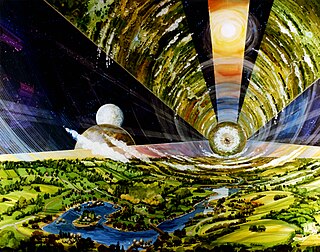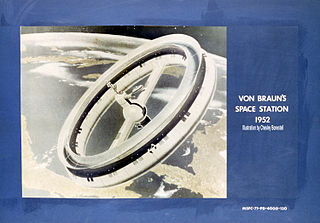Related Research Articles
Known Space is the fictional setting of about a dozen science fiction novels and several collections of short stories by American writer Larry Niven. It has also become a shared universe in the spin-off Man-Kzin Wars anthologies. The Internet Speculative Fiction Database (ISFDB) catalogs all works set in the fictional universe that includes Known Space under the series name Tales of Known Space, which was the title of a 1975 collection of Niven's short stories. The first-published work in the series, which was Niven's first published piece, was "The Coldest Place", in the December 1964 issue of If magazine, edited by Frederik Pohl. This was the first-published work in the 1975 collection.

In celestial mechanics, the Lagrange points are points of equilibrium for small-mass objects under the gravitational influence of two massive orbiting bodies. Mathematically, this involves the solution of the restricted three-body problem.

Ringworld is a 1970 science fiction novel by Larry Niven, set in his Known Space universe and considered a classic of science fiction literature. Ringworld tells the story of Louis Wu and his companions on a mission to the Ringworld, an enormous rotating ring, an alien construct in space 186 million miles in diameter. Niven later wrote three sequel novels and then cowrote, with Edward M. Lerner, four prequels and a final sequel; the five latter novels constitute the Fleet of Worlds series. All the novels in the Ringworld series tie into numerous other books set in Known Space. Ringworld won the Nebula Award in 1970, as well as both the Hugo Award and Locus Award in 1971.

A Bernal sphere is a type of space settlement intended as a long-term home for permanent residents, first proposed in 1929 by John Desmond Bernal.

A space settlement is a more advanced form of habitation in outer space than a space station or habitation module, in that it is intended as a permanent settlement or green habitat rather than as a simple way-station or other specialized facility. No space settlement has been constructed yet, but many design concepts, with varying degrees of realism, have come both from engineers and from science-fiction authors.

The Stanford torus is a proposed NASA design for a space settlement capable of housing 10,000 to 140,000 permanent residents.

A Klemperer rosette is a gravitational system of (optionally) alternating heavier and lighter bodies orbiting in a symmetrical pattern around a common barycenter. It was first described by W.B. Klemperer in 1962, and is a special case of a central configuration.

A megastructure is a very large artificial object, although the limits of precisely how large vary considerably. Some apply the term to any especially large or tall building. Some sources define a megastructure as an enormous self-supporting artificial construct. The products of megascale engineering or astroengineering are megastructures.

The Smoke Ring is a 1987 science fiction novel by Larry Niven. Like much of Niven's work, the story is heavily influenced by the setting: a gas torus, a ring of air around a neutron star. It is a sequel to The Integral Trees.

An orbital ring is a concept of an artificial ring placed around a body and set rotating at such a rate that the apparent centrifugal force is large enough to counteract the force of gravity. For the Earth, the required speed is on the order of 10 km/sec, compared to a typical low Earth orbit velocity of 8 km/sec. The structure is intended to be used as a space station or as a planetary vehicle for very high-speed transportation or space launch.
The L5 Society was founded in 1975 by Carolyn Meinel and Keith Henson to promote the space colony ideas of Gerard K. O'Neill.

A topopolis is a proposed tube-shaped space habitat, rotating to produce artificial gravity via centrifugal force on the inner surface, which is extended into a loop around the local planet or star. The concept was invented by writer Patrick Gunkel.

The High Frontier: Human Colonies in Space is a 1976 book by Gerard K. O'Neill, a road map for what the United States might do in outer space after the Apollo program, the drive to place a human on the Moon and beyond. It envisions large human occupied habitats in the Earth-Moon system, especially near stable Lagrangian points. Three designs are proposed: Island one, Island two, and Island 3. These would be constructed using raw materials from the lunar surface launched into space using a mass driver and from near-Earth asteroids. The habitats were to spin for simulated gravity and be illuminated and powered by the Sun. Solar power satellites were proposed as a possible industry to support the habitats.

Lagrange point colonization is a proposed form of space colonization of the five equilibrium points in the orbit of a planet or its primary moon, called Lagrange points.

A rotating wheel space station, also known as a von Braun wheel, is a concept for a hypothetical wheel-shaped space station. Originally proposed by Konstantin Tsiolkovsky in 1903, the idea was expanded by Herman Potočnik in 1929.
A McKendree cylinder is a type of hypothetical rotating space habitat originally proposed at NASA's Turning Goals into Reality conference in 2000 by NASA engineer Tom McKendree. Like other space habitat designs, the cylinder would spin to produce artificial gravity by way of centrifugal force. The design differs from the classical designs produced in the 1970s by Gerard K. O'Neill and NASA in that it would use carbon nanotubes instead of steel, allowing the habitat to be built much larger. In the original proposal, the habitat would consist of a cylinder approximately 460 km (290 mi) in radius and 4,600 km (2,900 mi) in length, containing 13 million km2 (5 million sq mi) of living space, nearly as much land area as that of Russia.
Engineering on an astronomical scale, or astronomical engineering, i.e., engineering involving operations with whole astronomical objects, is a known theme in science fiction, as well as a matter of recent scientific research and exploratory engineering.

An O'Neill cylinder is a space settlement concept proposed by American physicist Gerard K. O'Neill in his 1976 book The High Frontier: Human Colonies in Space. O'Neill proposed the colonization of space for the 21st century, using materials extracted from the Moon and later from asteroids.
"Bigger Than Worlds" is an essay by the American science fiction writer Larry Niven. It was first published in March 1974 in Analog magazine, and has been anthologized in A Hole in Space (1974) and in Playgrounds of the Mind (1991). It reviews a number of proposals, not inconsistent with the known laws of physics, which have been made for habitable artificial astronomical megastructures.
References
- 1 2 Rain Noe, "Space Colony Form Factors, Part 3: The Stanford Torus and Beyond", Core77, Aug. 07, 2015. Retrieved 28 May 2018.
- 1 2 3 4 Forrest Bishop, "Open Air Space Habitats", Institute of Atomic-Scale Engineering, 1997. Retrieved 28 May 2018.
- ↑ Adam Hadhazy, "Could We Build a Ringworld?", Popular Mechanics, Sep 4, 2014. Retrieved 28 May 2018.
- ↑ M. Alan Kazlev, Todd Drashner and Steve Bowers, "Bishop Ring", Encyclopaedia Galactica website, October 8 2001. Retrieved 28 May 2018.
